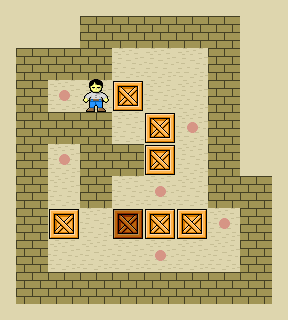Sokoban facts for kids
Sokoban (倉庫番, Sōko-ban) is a fun puzzle video game where you push boxes around. Imagine you're in a warehouse and you need to move all the crates to special spots. That's what Sokoban is all about! This clever game was invented in Japan in 1981 by Hiroyuki Imabayashi. The very first game you could buy came out in December 1982. It was made by a company called Thinking Rabbit in Takarazuka, Japan.
Contents
How to Play Sokoban
The game takes place on a board made of squares. Each square is either a floor or a wall. Some floor squares have boxes on them. Other floor squares are marked as special storage spots.
You control a character on the board. You can move your character left, right, up, or down. You can only move onto empty floor squares. You cannot walk through walls or through boxes.
The main goal is to move boxes. You can push a box by walking up to it and moving into it. This makes the box slide to the square beyond it. You cannot pull boxes. Also, you cannot push a box if there is a wall or another box right behind it.
The puzzle is solved when every single box is pushed onto a storage location. The number of boxes always matches the number of storage spots. So, you need to get every box to its correct place!
Popular Sokoban Games
Over the years, many different versions of Sokoban have been released. Here are some of the well-known ones:
| Year | Title | Country | Platform | Publisher | Media |
|---|---|---|---|---|---|
| 1982 | Sokoban (倉庫番) | Japan | NEC PC-8801 | Thinking Rabbit | Tape |
| 1983 | Sokoban [Extra Edition] (倉庫番[番外編]) | Japan | NEC PC-8801 | PCマガジン | Source code |
| 1984 | Sokoban 2 (倉庫番2) | Japan | NEC PC-8801 | Thinking Rabbit | Tape |
| 1988 | Soko-Ban | US | IBM-PC and compatibles | Spectrum HoloByte | Floppy |
| 1989 | Soko-ban Perfect (倉庫番Perfect) | Japan | NEC PC-9801 | Thinking Rabbit | Floppy |
| 1990 | Boxyboy | Japan, US | Turbografx-16 and PC Engine | NEC | HuCard |
| 1991 | Soko-ban Revenge (倉庫番Revenge) | Japan | NEC PC-9801 | Thinking Rabbit | Floppy |
| 2016 | Sokoban Touch (倉庫番Touch) | Japan, US | Android and Apple iOS | Thinking Rabbit | Digital distribution |
Where You Can Play Sokoban
Sokoban games have been made for many different computer platforms. You can find versions for almost all home computers and personal computers. There are also versions for video game consoles, mobile phones, graphic calculators, digital cameras, and even electronic organizers.
Different Ways to Play Sokoban
Many puzzles are like Sokoban because they involve a character pushing boxes in a maze. Here are some cool variations:
- Different Shapes for the Board: In the usual Sokoban, the mazes are on a square grid. But some versions use other shapes! Hexoban uses hexagons, and Trioban uses triangles.
- More Than One Pusher: In games like Multiban and Interlock, you can control more than one character at a time. This means more pushing power!
- New Goals: Some games change what you need to do to win a level. For example, in Block-o-Mania, boxes have different colors. You have to push them onto matching colored squares. In CyberBox, you just need to reach a special exit square.
- Extra Game Stuff: Games like Push Crate and Cyberbox add new things to the puzzle. These can include holes, teleporters, moving blocks, or passages that only let you go one way. The original 1982 Sokoban even had walls you could break!
- Pulling Boxes: In a game called Pukoban, your character can not only push boxes but also pull them. This adds a whole new way to solve puzzles!
- Playing Backwards: You can sometimes solve a Sokoban puzzle by playing it in reverse. This means you start from the end and pull boxes back to the beginning. This can sometimes help you figure out the regular puzzle!
See also
 In Spanish: Sokoban para niños
In Spanish: Sokoban para niños


